- home
- BAKERECIPES
BakeRecipes
Bringing real baking into your home with deliciously simple recipes.
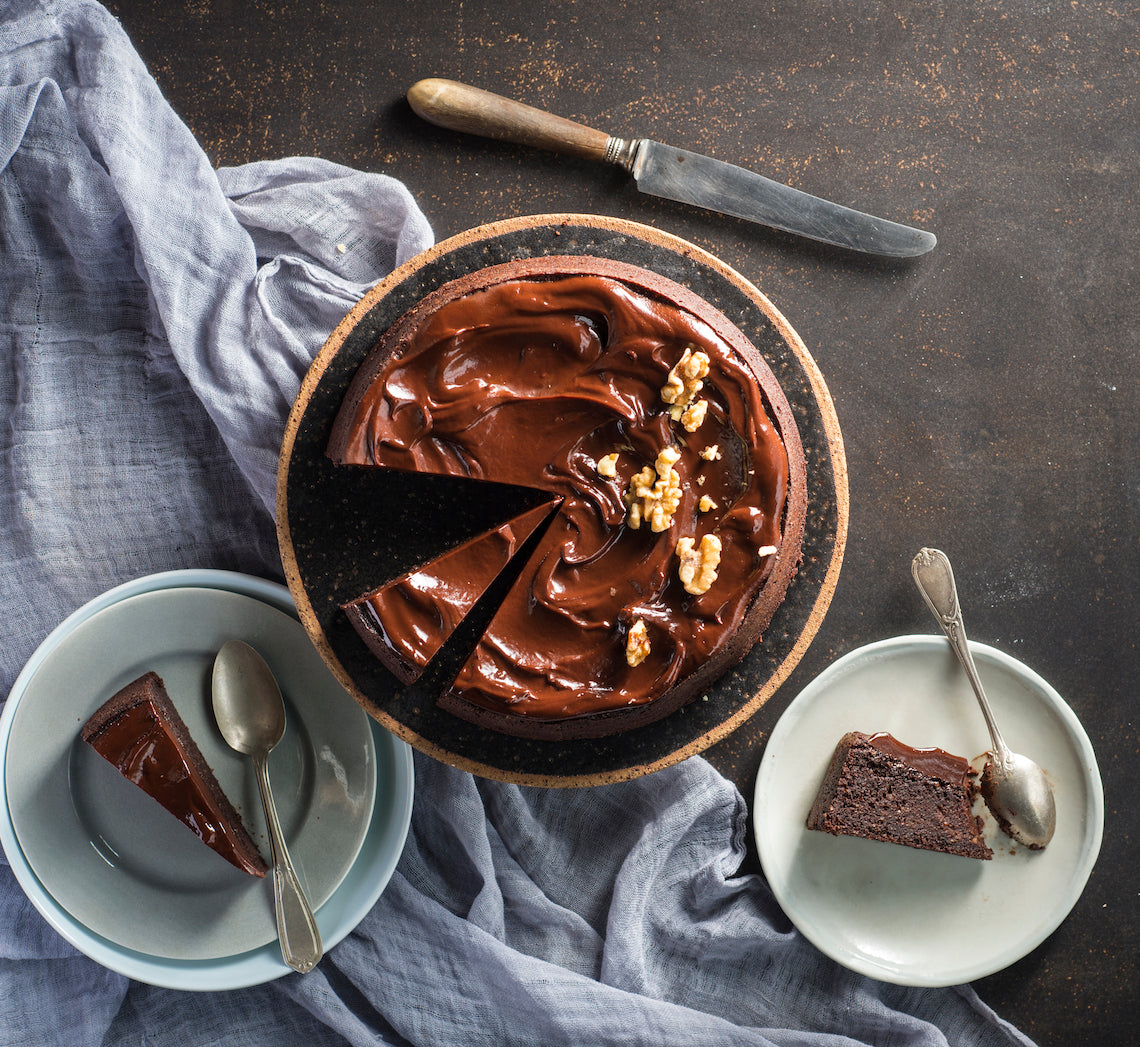
Prep 30min (+cooling and standing time)Bake 40-45minMakes 10-12 serves
With an underlying hint of orange and the warm nuttiness of roasted walnuts, this divine cake completely delivers when it comes to a rich, decadent and utterly satisfying chocolate cake.
Gluten-free chocolate cakes have been widely adapted as the Passover dessert of choice, and with the absence of dairy, this one is also appropriate to serve following a meat-based main course.
Ingredients
75g (⅔ cup) Dutch cocoa powder, sifted
165ml (⅔ cup) boiling water
200g walnuts, toasted
1 teaspoon gluten-free baking powder
4 x 59g eggs, at room temperature
220g (1 cup, firmly packed) brown sugar
200ml light olive oil, plus extra to grease
1 teaspoon natural vanilla essence or extract
1 tablespoon finely grated orange zest
Coconut Ganache
180g good-quality dairy-free dark chocolate, chopped
150ml tinned full-fat coconut milk
Method
- Preheat oven to 170°C (150°C fan-forced). Grease a 20cm springform tin with extra oil and line the base with non-stick baking paper.
- Place the cocoa in a medium heat-proof bowl and gradually stir in the boiling water until smooth. Set aside to cool.
- Process the walnuts in a food processor until finely ground. Transfer to a medium bowl and stir in the baking powder until evenly combined.
- Use an electric mixer with a whisk attachment to whisk the eggs, sugar, oil and vanilla on high speed for about 5 minutes or until thick and paler in colour. Add the cocoa mixture and whisk until just combined. Add the walnut mixture and orange zest to the chocolate mixture and whisk on low speed until just combined.
- Pour the mixture into the prepared tin and bake in preheated oven for 40-45 minutes or until wet crumbs cling to a skewer inserted into the centre of the cake. Cool the cake in the tin sitting on a wire rack (this will take about 2 hours).
- To make the Coconut Ganache, place the chocolate in a heatproof bowl. Heat the coconut milk in a small saucepan over medium heat, stirring occasionally, until it just comes to a simmer (do not boil). Pour over the chocolate and set aside for 1 minute. Stir until the chocolate melts and the mixture is smooth, well combined and glossy. Set aside at room temperature, stirring occasionally, until the ganache thickens to a thick spreadable consistency.
- Remove the cake from the tin and place on serving plate. Spoon the ganache over the cooled cake and use the back of a spoon to spread. Set aside for 30 minutes or until the ganache sets. Serve in wedges.
Baker's Tip
- This cake will keep in an airtight container at room temperature (in a cool spot) for up to 5 days.
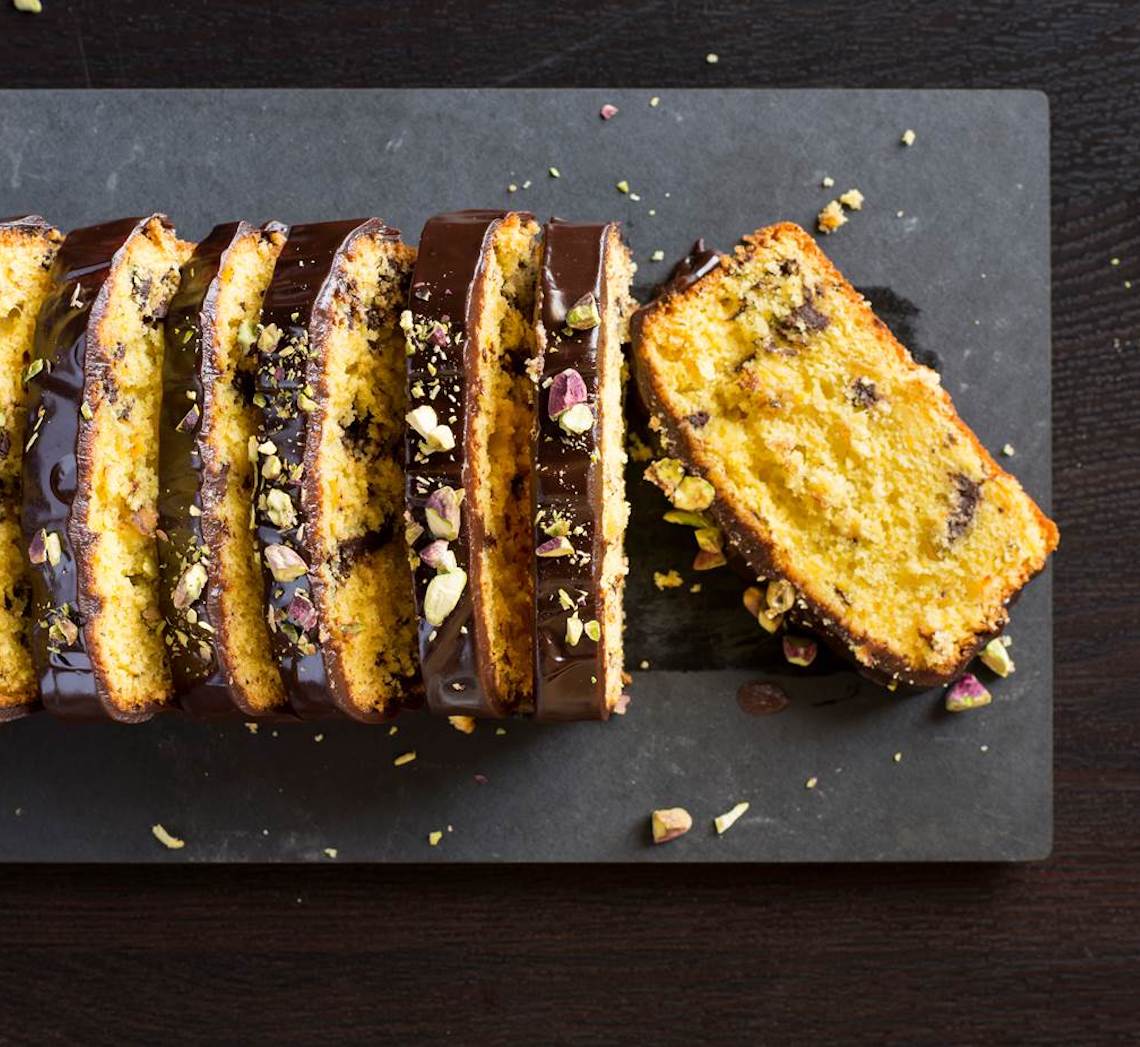
Prep 25min (+ 1hr chilling, 2hr cooling and 30min standing time)Bake 1hrMakes 10 serves
Choc-orange, or jaffa, is such a great flavour. This dead-easy cake is made completely in the food processor using a whole orange, rind and all (no that isn’t a mistake!). Orange flower water is optional in this recipe but will give the cake a slightly more ‘refined’ orange character.
Ingredients
1 orange, quartered, core and seeds removed
220g (1 cup) caster sugar
125g butter, melted and cooled
2 eggs, at room temperature
1 tabsepoon orange flower water, or to taste (optional)
185g (1¼ cups) self-raising flour
35g (¼ cup) plain flour
100g good-quality dark chocolate (54% cocoa), chopped
35g (¼ cup) coarsely chopped toasted pistachios, to sprinkle
Chocolate glaze
150g good-quality dark chocolate (54% cocoa), chopped
125ml (½ cup) pouring cream
Method
- Preheat oven to 170ºC (150ºC fan-forced). Grease 11cm x 21cm (base measurement) loaf tin with melted butter and line the base and two long sides with non-stick baking paper.
- Place the whole orange, sugar, butter, eggs and orange flower water in the bowl of a food processor. Process until the orange is finely chopped. Add the self-raising and plain flours and process until just combined. Transfer the mixture to a bowl and use a large metal spoon or spatula to fold in the chocolate.
- Pour the mixture into the prepared tin and use the back of a spoon to smooth the surface. Bake in preheated oven for 60 minutes or until a skewer inserted into the centre comes out clean. Remove from the oven and set aside for 5 minutes before transferring onto a wire rack to cool (this will take about 2 hours). Place the cake, still on the wire rack in the fridge for 1 hour to chill (this will help the glaze set).
- Meanwhile, to make the chocolate glaze, place the chocolate in a heatproof bowl. Heat the cream in a small saucepan over medium heat until almost simmering. Pour over the chocolate and stand for 1 minute. Stir until melted and smooth. Set aside to until cooled to room temperature. Pour the glaze over the cake on the wire rack, allowing it to drizzle down the sides. Sprinkle with the pistachios and set aside for 30 minutes or until the glaze sets. Serve in slices.
Baker's Tips
- This cake will keep in an airtight container at room temperature for up to 3 days.
This recipe is from Anneka's SBS Food online column, Bakeproof: Easy Chocolate Cakes. CLICK HERE for more Bakeproof recipes.
Photography by Alan Benson.
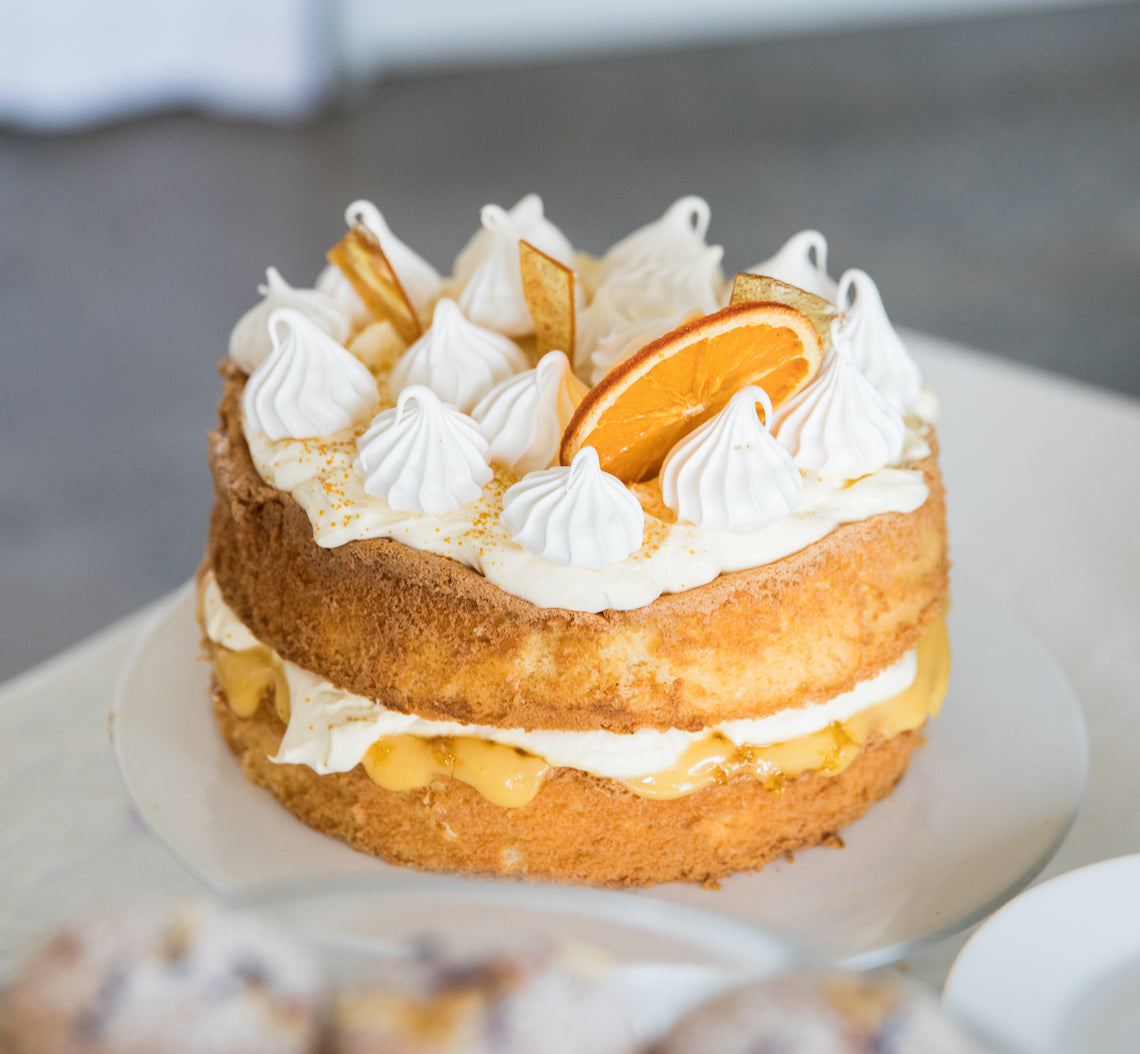
Prep 1.5hr (+ Meringue Rosettes prep)Bake 18-20minMakes 8-10 serves
An absolute must-try for any citrus fan, this light-as-air cake is the ultimate balance between light sponge, mouth-puckering lemon curd and beautiful hand-made adornments.
Created by Make Me a Baker student, Cate Tibbertsma for her graduation, this cake is a nostalgic one "that will fill your belly with sweet memories" as Cate says.
Ingredients
125ml (½ cup) thickened cream
125g (½ cup) sour cream
1 tablespoon pure icing sugar, sifted
1 teaspoon Citrus Dust (see recipe below), plus extra to sprinkle
Meringue Rosettes (get Cate's meringue recipe HERE), to decorate
Oven-dried orange slices (optional), to decorate
Lemon Curd
2 eggs, at room temperature
2 egg yolks, at room temperature
165g (3/4 cup) caster sugar
80g unsalted butter, diced
2 lemons, zest finely grated and juiced
Sponge Layers
Melted butter to grease
4 fresh eggs, at room temperature
1½ teaspoons natural vanilla essence or extract
165g (3/4 cup) caster sugar
60ml (1/4 cup) milk
30g butter, diced
110g (3/4 cup) self-raising flour
30g (1/4 cup) cornflour
Citrus Syrup
110g (½ cup) caster sugar
60ml (1/4 cup) strained fresh lemon juice
60ml (1/4 cup) strained fresh orange juice
Citrus Toffee Shards
Oil spray
100g caster sugar
2½ tablespoons water
1 tablespoon liquid glucose
½ teaspoon Citrus Dust (see recipe below), to sprinkle
Lemon Curd
- Combine the whole eggs, yolks and sugar in a small saucepan and stir with a whisk until smooth. Add the butter and the lemon juice and zest.
- Place the saucepan over a low heat and stir constantly with the whisk until thickened and the mixture reaches 75°C on a sugar thermometer.
- Strain through a sieve into a sterilised jar or glass container with lid. Refrigerate until required (see Baker’s Tips).
Citrus Toffee Shards
- Line a baking tray with non-stick baking paper and spray lightly with oil; set aside. Combine the caster sugar, water and the liquid glucose in a small saucepan. Stir over a low heat until the sugar dissolves. Stop stirring when it starts to boil and brush down the inside of the saucepan with a wet pastry brush to dissolve any crystals that have formed on the surface. Boil until the syrup turns a dark caramel colour (see Baker's Tips).
- Immediately pour the caramel over the entire surface of the baking sheet to create a thin layer. Sprinkle with the Citrus Dust. Set aside to cool and set. When completely cool, transfer to a sealed airtight container together with the baking paper.
Sponge Layers
- Position the oven rack in the middle of the oven and then preheat it to 180°C (160°C fan-forced). Brush two 18cm springform tins with melted butter to grease and line the base of each with a sheet of non-stick baking paper. Combine butter and milk in a small saucepan and set aside. Combine the Citrus Syrup ingredients in a separate small saucepan and set aside also.
- Use an electric mixer with a whisk attachment on medium-high speed to whisk the eggs and vanilla in a medium bowl until frothy. Add the sugar a spoonful at a time, whisking well between each addition, until the mixture is very thick and pale and the sugar has dissolved (this will take about 8 minutes). Lift the whisk out of the mixture and slowly draw a figure eight, if the trail stays on the surface long enough for you to finish drawing then the mixture is ready. If not, continue to whisk for a further minute and then test again.
- Meanwhile, heat the milk and butter in a small saucepan over medium heat until the butter melts and the mixture is almost simmering. Remove from the heat. Pour the hot milk mixture down the side of the bowl and then sift the flour and cornflour together over the egg mixture. Immediately whisk briefly again with the electric mixer on low speed, until the flour mixture is just incorporated (make sure there is no flour caught at the bottom of the bowl and be careful not to over mix).
- Divide the mixture evenly between the cake tins (see Baker's Tips) and gently tap the tins on the bench top three times to settle the mixture. Bake in preheated oven for 18-20 minutes or until the cakes are a pale golden colour, spring back when lightly touched in the centre and start pulling away from the sides of the tins.
Citrus Syrup
- About 5 minutes before the Sponge Layers finish baking, place the saucepan with the Citrus Syrup ingredients over a medium heat and stir until the sugar dissolves. Bring to a boil then reduce to a very gentle simmer to keep warm.
- Remove sponges from the oven and immediately use a small palette knife to loosen the top of the sponges from the tins and turn onto a wire rack lined with a tea towel. Remove the baking paper and carefully turn the hot sponges back on their base onto a rack over a tray. Immediately pour hot syrup over the hot sponge layers. Set aside to cool completely before layering.
To Assemble
- Use an electric hand mixer with a whisk attachment or a balloon whisk to whisk the thickened cream, sour cream and icing sugar together in a medium bowl, until soft peaks form.
- Place one sponge layer on a serving plate or cake stand. Spread about 1/2 cup of curd over the sponge layer and use a small sieve to sprinkle the Citrus Dust over the curd. Spread about half the cream mixture over the curd layer, spreading gently to avoid over-working the cream. Top with the remaining sponge layer. Spread another 1/2 cup of curd on top followed by the remaining cream mixture, again spreading gently so you don’t over work it.
- Decorate with the Meringue Rosettes and Citrus Toffee Shards and sprinkle with extra Citrus Dust. Embellish with oven-dried orange slices, if desired. Serve immediately or refrigerate for up to 2 hours (see Baker's Tips).
ORANGE CITRUS DUST: Preheat oven to 100°C (80°C fan-forced). Use a vegetable peeler to peel the rind from 1 large orange. Use a small knife to scrap any excess pith away. Place on a lined oven tray and bake in oven for 1-2 hours. Rind is ready when it has dried completely but still retains some of its original colour. Use a mortar and pestle or a small food processor to pound or process the rind to a fine powder that is aromatic and rich in colour. Store in an airtight container in a cool dry place for up to one month.
Baker's Tips
- The Lemon Curd will keep in a sealed clean, sterilised jar for up to 2 weeks in the fridge. My preference is to make and refrigerate the lemon curd 1-2 days in advance of using it so that the curd thickens and the flavour develops.
- As the Citrus Toffee Shards syrup begins to darken, gently turn the pan to encourage the colour to spread but avoid swirling the mixture too vigorously to prevent the mixture from crystallising.
- The Citrus Toffee Shards will store at room temperature in an airtight container for up to a month, depending on the humidity.
- Having your butter and milk mixture for the Sponge Layers and the Citrus Syrup ingredients in separate saucepans, ready for heating, will make the preparation of this recipe more efficient and with help with the timing of when the different elements need to be ready.
- To divide the mixture evenly between the tins, weigh the tins with the mixture in them to make sure they are the same weight. Placing a small upturned bowl on the scale and for the cake tin to sit on will mean that the measurement display window can be easily viewed.
- Even though this cake is best eaten on the day it is baked, the unfilled syrup-infused sponge layers can be made the day before serving. Store in an airtight container at room temperature. To avoid the layers sticking to each other, separate the sponges with a layer of baking paper or store in two separate airtight containers. An upturned cake tin, larger than the diameter of the cake, also makes a useful barrier for separating sponges for storing.
- To ensure this cake cuts easily, resist over-filling the middle layer of curd and cream and, if possible, chill the assembled cake for a few hours before serving. Decorate with the meringues, toffee shards and citrus dust just before serving.
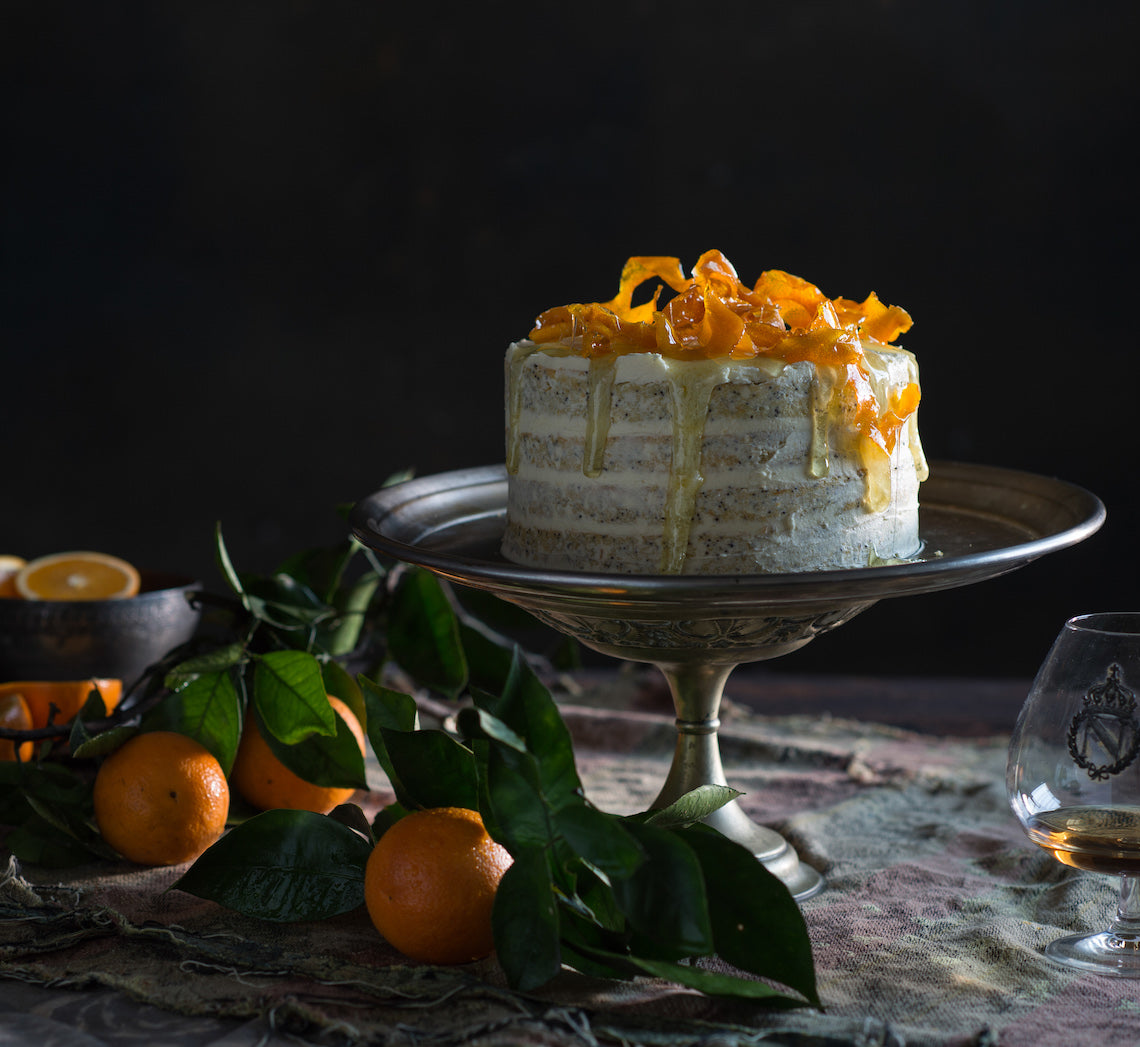
Prep 45min (+30min cooling time per batch)Bake 45minMakes 12-14 serves
This pretty cake, with its heavenly orange blossom-scented frosting, is currently one of my favourite 'special occasion' cakes – particularly for birthday celebrations. The cake layers are baked in two batches but if you are lucky enough to have four cake pans that can fit in your oven all at once, feel free to make the mixture in one lot and bake them all together.
Ingredients
Melted butter, to grease
Orange poppy seed cake layers
3 oranges
3 tablespoons poppy seeds
125g (½ cup) sour cream
250g butter, cubed, at room temperature
300g (1⅓ cups) caster sugar
4 eggs
350g (2⅓ cups) plain flour
3 teaspoons baking powder
Candied orange rind
3 oranges
220g (1 cup) caster sugar
250ml (1 cup) water
Orange blossom water buttercream
250g butter, at room temperature
375g (3 cups) icing sugar, sifted
3-4 teaspoons orange blossom water (or to taste)
Method
- To make the cake layers, preheat the oven to 180°C. Grease two shallow 20cm (base measurement) round cake tins with melted butter and line the bases with rounds of non-stick baking paper.
- Finely grate the rind from the oranges and set aside. Juice the fruit and measure 125ml (½ cup), reserving the rest for another use. Divide the juice evenly between two medium bowls. Add half the poppy seeds and half the sour cream to each. Set aside.
- Use an electric mixer to beat 125g of the butter, 150g of the sugar and half the orange rind until pale and creamy. Add 2 of the eggs, one at a time and beating well after each addition. Sift together 175g of the flour and 1½ teaspoon of the baking powder. Fold half the flour mixture through the butter mixture until just combined. Fold through one quantity of the poppy seed mixture and then the remaining flour mixture until just combined.
- Divide the cake mixture evenly between the prepared cake tins and use the back of a metal spoon to smooth the surfaces. Bake in the preheated oven for 20-25 minutes or until a skewer inserted into the centre of the cakes come out clean. Stand in the tins for 5 minutes before turning onto wire racks, topside down, to cool (this will take about 30 minutes).
- Repeat with the remaining poppy seed mixture and ingredients to make two more cake layers.
- Meanwhile, to make the candied orange rind, use a vegetable peeler to remove the rind from the oranges in wide strips. Use a small sharp knife to remove any white pith from the rind. Combine the sugar and water in a small saucepan and stir over low heat until the sugar dissolves. Add the orange rind strips and bring to a simmer. Simmer, without stirring, for 10-15 minutes or until the rind is translucent. Use a fork to transfer the rind from the syrup to a wire rack. Set aside. Reserve the syrup.
- To make the orange blossom water buttercream, use an electric mixer to beat the butter, icing sugar and orange blossom water in a medium bowl until very pale and creamy. Cover and set aside at room temperature.
- To assemble the cake, place a cake layer, topside down, on a serving plate or cake stand. Spread with a little of the buttercream and then top with another layer of cake. Continue to layer with some of the remaining buttercream and cake layers, finishing with a cake layer. Spread a thin layer of buttercream around the outside of the cake so that the cake layers show through. Spread the remaining buttercream on top, swirling as desired. Decorate with the candied orange rind and drizzle with some of the remaining syrup just before serving.
Baker's Tips
- This cake will keep in an airtight container at room temperature for up to 3 days.
This recipe is from Anneka's SBS Food online column, Bakeproof: Citrus.
CLICK HERE for more Bakeproof recipes.
Photography by Alan Benson.
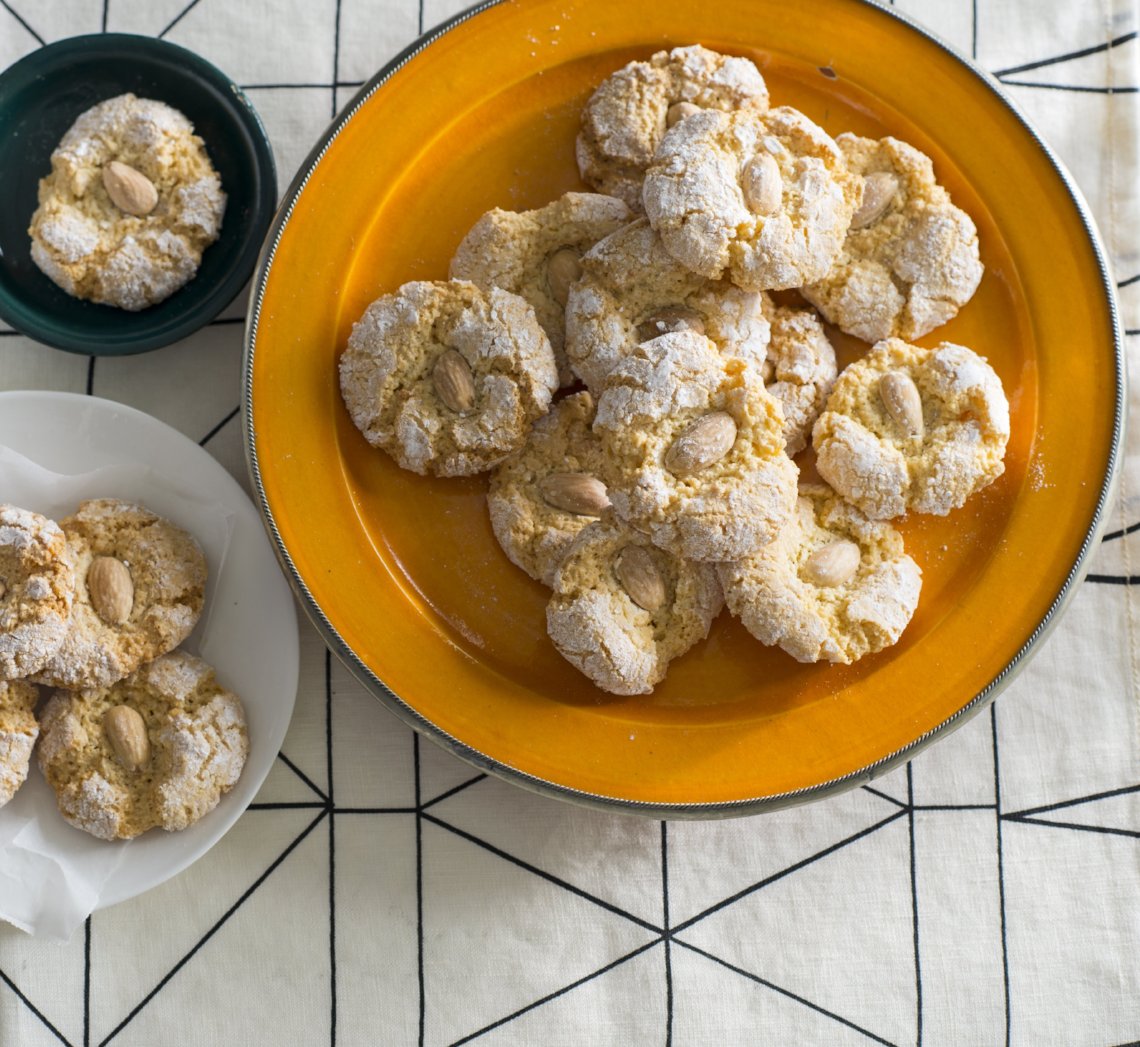
Prep 20minBake 30minMakes about 30
These "very Moroccan" cookies are dead-easy to make, but still special with the addition of orange flower water. They have a crisp macaroon-like character that softens and becomes chewy the longer they're kept.
Ingredients
240g (1½ cups) blanched almonds, plus 30 extra to decorate (optional)125g (1 cup) pure icing sugar, plus 2 tablespoons extra to coat
1 teaspoon baking powder
3 egg yolks
2 teaspoons orange flower water
Method
- Preheat oven to 180°C (160°C fan-forced). Line two large oven trays with non-stick baking paper.
- Spread the almonds on one of the baking trays and toast in preheated oven, shaking the tray occasionally, for 8-10 minutes or until lightly golden and aromatic. Set aside for 5 minutes to cool slightly.
- Use a food processor to process the almonds until finely ground. Transfer to a medium mixing bowl.
- Sift together the icing sugar and baking powder over the almond meal. Add the egg yolks and orange flower water and use an electric mixer to beat until well combined and a soft dough forms. Roll heaped teaspoonfuls of the mixture into balls. Roll in the extra icing sugar to coat lightly and then place on the lined oven trays about 5cm apart. Flatten the balls until about 1cm thick and then press a whole extra almond into the center of each, if desired.
- Bake in preheated oven for 20 minutes, swapping the trays around halfway through baking, or until lightly golden around the edges and cracked on top. Remove from the oven and cool on the trays.
Baker's Tips
- These ghoribas will keep in an airtight container at room temperature for up to 2 weeks.
- For a slightly soft centre bake these biscuits for only 16 minutes.
This recipe is from Anneka's SBS Food online column, Bakeproof: Moroccan Spice.
CLICK HERE for more Bakeproof recipes.
Photography by Alan Benson.
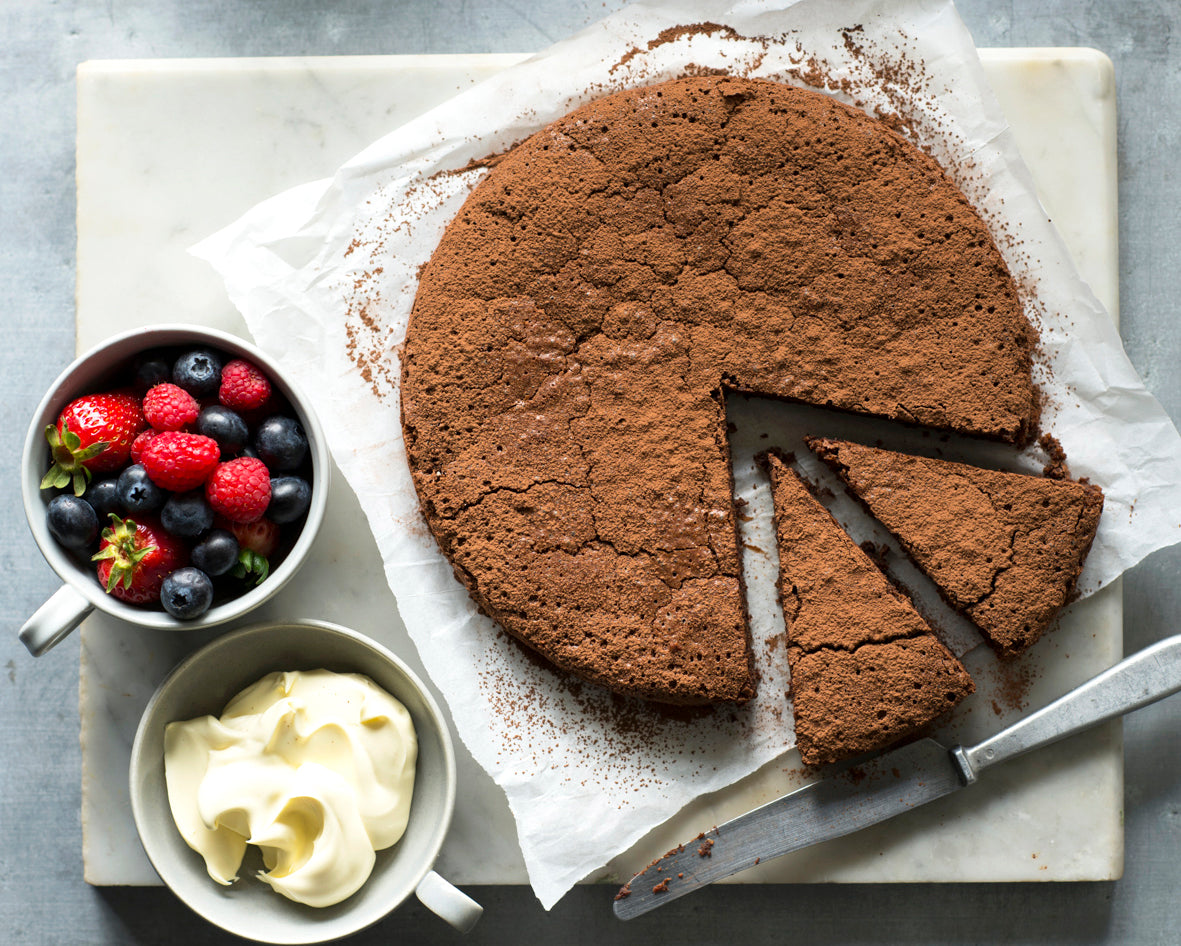
Prep 20minBake 55minMakes 8-10 serves
This cake is a favourite of mine – it is rich but light all at the same time. The chocolate, egg yolks and hazelnut meal provide the richness while the egg whites account for the light texture. It is indulgent without being overwhelmingly rich – my sort of chocolate cake. It makes a perfect dessert when served with thick cream or ice cream but don’t underestimate how blissfully suitable a slice with afternoon coffee can be.
Ingredients
Melted butter, to grease150g good-quality dark chocolate, chopped
100g butter, cubed
4 eggs, at room temperature, separated
110g (½ cup) caster sugar
110g (1 cup) hazelnut meal
2 tablespoons sherry, brandy or Frangelico
Cocoa powder or icing sugar, to dust
Method
- Preheat the oven to 150°C (130°C fan-forced). Grease a 22cm (base measurement) springform tin with the melted butter, then line the base and side with baking paper.
- Combine the chocolate and butter in a medium heatproof bowl over a saucepan of simmering water (don’t allow the bowl to touch the water). Stir occasionally until the chocolate and butter melt and the mixture is smooth. Remove the bowl from the pan.
- Add the egg yolks, sugar, hazelnut meal and sherry to the chocolate mixture and use a balloon whisk to stir until well combined. Transfer the mixture to a large bowl.
- Place the egg whites in a clean, dry medium bowl and use electric beaters with a whisk attachment to whisk until firm peaks form. Add a spoonful of egg white to the chocolate mixture and use a large metal spoon or spatula to fold in – this will ‘loosen’ the mixture. Add the remaining egg white and fold in until just combined.
- Pour the mixture into the prepared tin and use the back of a spoon to smooth the surface. Bake in preheated oven for 55 minutes or until the top of the cake feels set and crumbs cling to a skewer inserted into the centre. Remove the cake from the oven, place on a wire rack and cool completely in the tin.
- Remove the cake from the ti and serve dusted with cocoa powder or icing sugar.
Baker's Tips
- This cake will keep in an airtight container in the fridge for up to 4 days. Bring it to room temperature before serving.
Variations
- Flourless Chocolate & Almond Cake: Replace the hazelnut meal with almond meal.
- Flourless Chocolate & Orange Cake: Replace the hazelnut meal with almond meal. Replace the sherry with 2 tablespoons orange liqueur (such as Grand Marnier or Cointreau). Add 1 tablespoon finely grated orange zest with the egg yolks.
- Flourless Chocolate Coffee Cake: Replace the sherry with 2 teaspoons instant coffee granules dissolved in 2 tablespoons water.
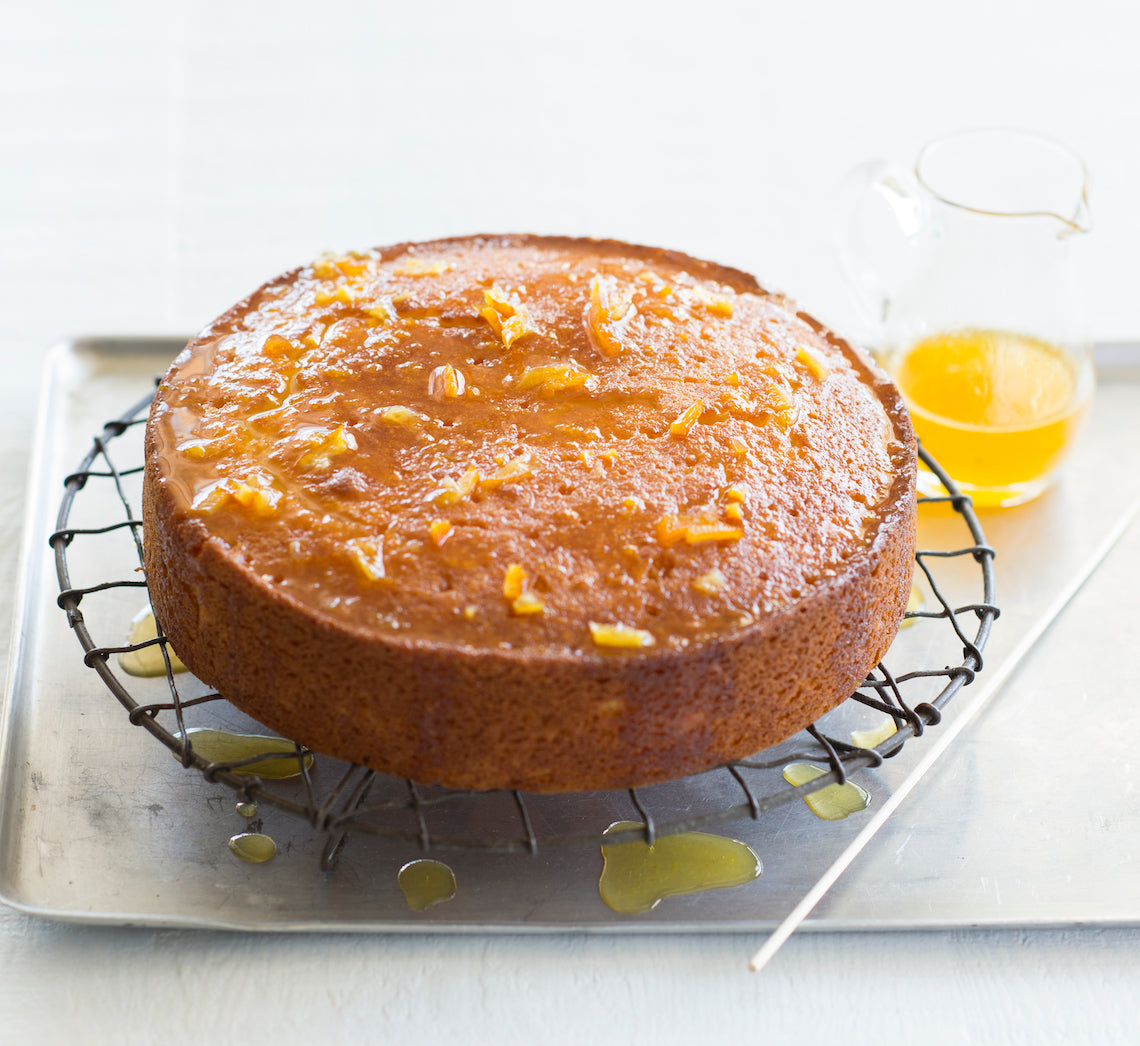
Prep 15minBake 50-60minMakes 8-10 serves
This is a wonderful cake that was originally inspired by a recipe my Aunt Joey used to make. No, it isn’t a mistake, a whole orange, rind and all goes into this cake. It is best to use a thin-skinned navel orange that is around in winter and spring, as it has no seeds and very little bitter pith.
It makes a wonderful dessert when served warm with vanilla ice-cream or a perfect picnic cake as it travels really well. The syrup keeps this cake deliciously moist and saves you from icing it – another great shortcut. If however you would prefer to ice it, a buttercream or glace icing flavoured with finely grated orange zest would be perfect.
Ingredients
Melted butter, to grease
1 orange (about 240g/8½oz), quartered, core and seeds removed
220g (1 cup/7¾oz) caster sugar
125g (4½oz) salted butter, melted and cooled
2 eggs, at room temperature
225g (1½ cups/8oz) self-raising flour
Orange syrup
250ml (1 cup/9fl oz) strained freshly squeezed orange juice
160g (½ cup/5¾oz) orange marmalade
75g (⅓ cup/2¾oz) caster sugar
Method
- Preheat oven to 170°C/340°F (150°C/300°F fan-forced). Grease a 20cm/8in round cake tin with melted butter and line the base with non-stick baking paper
- Place the quartered orange, sugar, butter and eggs in the bowl of a food processor. Process until the orange is finely chopped. Add the flour and process using the pulse button until just combined.
- Pour the mixture into the prepared tin and use the back of a spoon to smooth the surface. Bake in preheated oven for 50-60 or until a skewer inserted into the centre comes out clean. Remove from the oven and set aside for 5 minutes before turning onto a wire rack. Stand the rack over a baking tray.
- Meanwhile, to make the Orange Syrup, place the orange juice, marmalade and sugar in a small saucepan. Stir over medium heat until the sugar dissolves. Increase the heat to high and bring to the boil. Boil gently, uncovered and without stirring, for 5 minutes or until reduced slightly.
- Use a skewer to prick cake all over. Gradually pour the hot syrup over the hot cake, allowing it to soak in. Pour any syrup that has collected on the tray into a dish or jug, Serve warm or at room temperature with any syrup caught on the tray in a jug on the side.
Baker's Tips
- This cake will keep in an airtight container at room temperature for up to 4 days.
Image: Alan Benson






